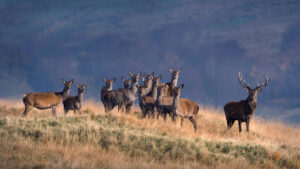ABOUT THE PILOT STUDY
The highlands are an iconic feature of Scotland. The open moorland and mountain landscapes are valued and enjoyed by both residents and visitors, while these areas also provide the resources for a range of activities such as hill farming, deer stalking, game birds, forestry and fishing, which help to support the rural economy. In recent years, a number of drivers of change have affected deer management in the uplands.
These fall into three into three broad areas. First, there has been an increasing policy emphasis on managing grazing impacts through reducing deer densities, especially for priority habitats.
Second, culling and fencing associated with increased woodland planting has affected deer numbers and distribution. Third, trends in recreation coupled with the Land Reform (Scotland) Act 2003 have led to increasing numbers of people accessing rural areas to walk in the mountains. These changes have led, in some cases, to conflicts between the legitimate objectives of landowners and the public benefits that highland landscapes provide.
An improved understanding of the nature of such conflicts might aid their management. Here, we focus on an example of where recreational land use might be impacting on the economics of deer stalking. Specifically, we report on a pilot study to identify whether available management information can be used to access trends in the abundance, culling levels, distribution and habitat preferences of red deer (Cervus elaphus L.), in order to determine whether further research into the drivers of change might be warranted
FURTHER READING

From Local Action to National Impact: Reducing Deer Suffering After Road Collisions
After 15 years of dedicated work by the Hampshire and Isle of Wight Constabulary (HIOWC), together with essential support from Dorothy Ireland, Tony Lowry, and numerous volunteers from The British Deer Society (BDS) plus expert deer managers in Hampshire and surrounding counties, we are delighted to see the HIOWC Humane Animal Dispatch (HAD) volunteer scheme poised for a national rollout.

Support BDS and Help Protect Deer and Their Habitats
Discover how the British Deer Society is working to protect deer, their habitats, and promote sustainable wildlife management. Learn about our mission, vision, and how you can support deer welfare through education, research, and donations. Join us in making a difference for deer and the environment.

The Role of Deer Management in Conservation in the UK
Deer management plays a crucial role in supporting conservation efforts across the UK, helping to restore habitats, preserve biodiversity, and address the challenges posed by rising deer populations. This article explores the importance of balancing deer numbers with ecosystem health, highlighting the impact of culling, stakeholder collaboration, and holistic management strategies.










